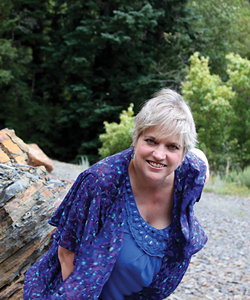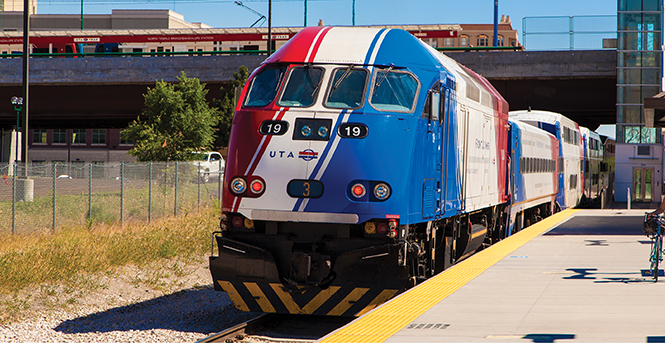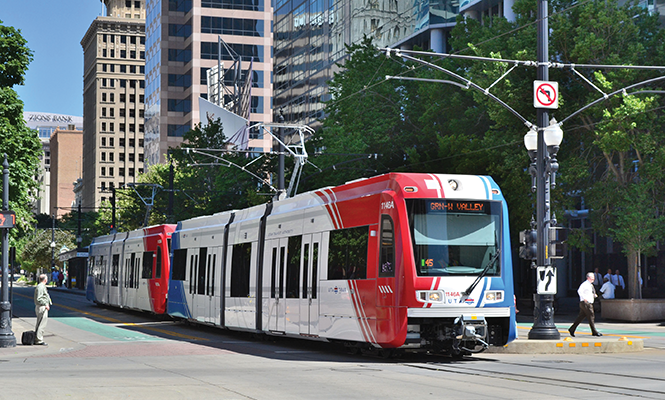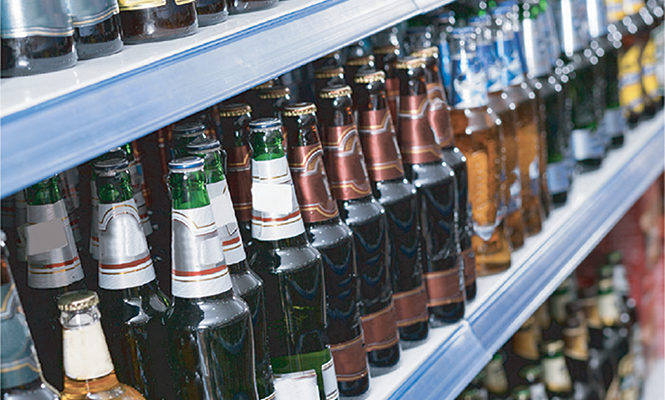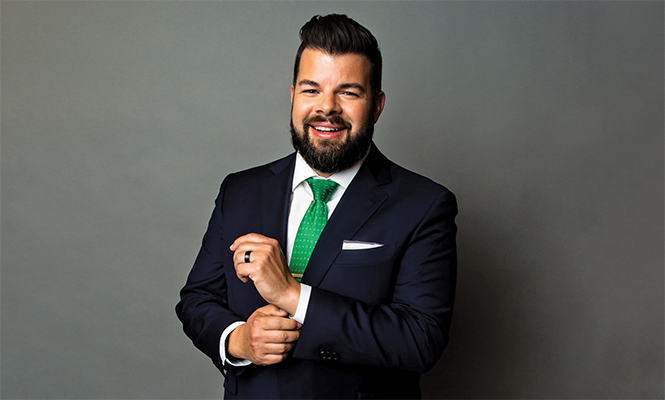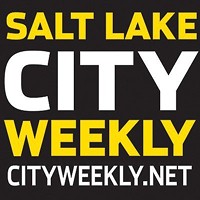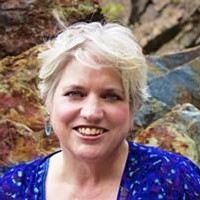City Guide 2023
City Weekly’s 19th annual celebration of all things SLC
By City Weekly Staff and Jerre Wroble @JerreWrobleFind Your Reason
Life in the Salt Lake Valley is a joy for some. Others find it “boring” (as Charles Barkley and Shaquille O’Neal quipped when they attended the NBA All-Star Game here in February). Still others see it as crowded and swarming with annoying drivers. Some find the wintertime smog or the Republican stranglehold of state government as reasons to bolt.
Yet, for the rest of us, here we are, for better or worse, either as resident or visitor. How did we get here? Family? Friends? A job? School? Religious zeal? A ski vacation? A long airport layover? Maybe you were just born here. There must be a reason, right? Kismet?
At the risk of sounding like a real estate agent, Salt Lake, despite its quirks, has it all, from awesome outdoor recreation to unique historical/cultural attractions (naturally, Temple Square is No. 1—but it’s undergoing major renovations at the moment, so pardon their dust).
We are home to notable events (Sundance Film Festival, anyone?), pro sports (the Utah Jazz basketball and Real Salt Lake soccer), dynamite shopping and entertainment malls, and diverse food and drink offerings that might seem beyond the ken of a Jell-O-loving people (but never underestimate the taste bud expansion of a returning Latter-day Saint missionary).
So how to align with the city’s vibes? Here’s what I would tell a friend.
1. Look for a locally owned coffee shop and plant yourself there for an hour or two. You’ll often find racks with free copies of our sister publication, City Weekly, that you can read to catch up on local news, events and shows. If the barista’s not too busy, maybe ask for tips on nearby parks, shops and landmarks to discover.
2. Find an indie bookstore or record store. We’ve listed more than a few in this publication, since such spots tend to be the culture keepers of our communities. Maybe the sales folks can help you find works by local writers or musicians that speak to Utah.
3. Take a drive (or a hike) up one of the seven canyons of the Wasatch mountains. Our canyons are special places, bordering on sacred. Get out of the car, look around and suck in the clean mountain air. If this doesn’t stir a bit of “wow” in you, then perhaps the SLC is not for you.
We find ourselves in a growing metropolis. Yet, in all the ways that count, Salt Lake is still a small town—one with a stunning scenic backdrop. And if you look for what you might enjoy in a small town (lunchtime concerts in the square, beer tasting at local breweries, tai chi in the park, Saturday morning farmers markets), you might feel you belong here, wherever you are in the Salt Lake Valley.
Let this guide help you find a reason to settle in.
Jerre Wroble
City Guide editor
Let’s Roll
The good and bad of getting around on Utah transit.
By Benjamin Wood
Utah, like much of the American West, is car country. That worked OK for a long time—assuming you could afford to buy a car and perpetually fill it with gasoline—but population growth, climate change, cost of living and Utah’s horrendous air quality have put enough pressure on the roads that even car-brained state leaders are beginning to acknowledge that, just maybe, “mistakes were made.”
Luckily, we’re not starting from Square 1. No, at minimum we’re at Square 2, maybe even Square 3. Here’s what to know about traveling without a car in Utah.
Good: It’s Free Downtown
A “free-fare zone” exists around Salt Lake City’s urban core, bordered by Salt Lake Central Station to the west, the Utah State Capitol to the north, the Main Library to the east and the Matheson Courthouse to the south. It doesn’t help much with bus service (you’d have to be taking a pretty short trip) but it’s handy for using Trax light rail to explore Main Street if you’re already downtown. Maybe you want to get some shopping in after a movie or grab a bite to eat before a Jazz game? Leave the car parked—or the bike locked—and use the trains to make a night of it.
Bad: Lawmakers Hate “Free”
The Utah Transit Authority (UTA) has run a number of free-fare initiatives, with things like airline boarding passes and concert tickets counting as transit fare. And in 2022, Salt Lake City pushed UTA to go fully free for the entire month of February. No surprise, these initiatives led to increased ridership. Gov. Spencer Cox called for a full year of free fares to study its effect on air quality and traffic congestion, but lawmakers were quick to shut down that kind of talk, lest it spread. “Nothing is free,” insisted Rep. Mike Schultz, R-Hooper, the No. 2 Republican in the Utah House. Following this statement, Schultz drove 45 minutes to his home along highways that were built at taxpayer expense on land ripped away from low-income, majority-minority residents, likely complaining about congestion the whole way.
Good: There Are Trains to Get You Around
The Trax Green Line is the best way to get to and from Salt Lake City International Airport, while the Red Line will run you up to the University of Utah (and Bonneville Shoreline Trail) or down south to the master-planned community of Daybreak. On the Blue Line, you can go hiking or mountain biking in Draper’s Corner Canyon or connect to a regional FrontRunner train or Amtrak’s cross-country train line, the California Zephyr, at Salt Lake Central.
Bad: Rail Is Poorly Planned and Largely Nonexistent
FrontRunner follows the Interstate 15 corridor, connecting Salt Lake City with Ogden to the north and Provo to the south. But the decision-makers who built it 20 years ago had no clue and left the train with one hand tied behind its back. With only hourly service outside of weekday rush hours and no service at all on Sundays, FrontRunner is not for beginners and requires concerted effort and planning on both ends of the trip. Train stations have few, if any, amenities and limited, if any, shelter from the elements. They tend to deposit riders into a sea of park-and-ride surface lots, because the train was foolishly designed to be driven to. And if you’re looking to go east or west away from I-15, you’re simply out of luck. No trains exist outside the Wasatch Front.
Good: There’s an App for That
Utah’s transit network doesn’t reward for spontaneity but there are ways to make it work for you. Thanks to funding from Salt Lake City, UTA recently began running high-frequency bus lines at 15-minute intervals, finally creating a limited number of routes for which schedule memorization is unnecessary. If you live, work, study and/or shop around those lines—and only those lines—you can experience true transit convenience. For other trips, the Transit app (transitapp.com) allows would-be riders to map their routes and purchase tickets. As this is not a UTA app, it works in many towns and cities you may happen to be in. It also provides live location tracking and notifications for when to deboard and what connections to make. Type in your destination and your starting point and the Transit app will show you a list of options with fairly accurate arrival time estimates. You can also text the ID number listed on your bus stop to 882-882 to see when the next buses serving that stop will arrive.
Bad: The Transit App Will Wipe Out Your Battery
The Transit app will get you where you’re going, but you might not have a working smartphone by the time you get there. Particularly with its “Go” feature activated—but even when it’s not—the app uses a staggering amount of battery power as it tracks not just your location but that of the various buses and trains snaking their way around the valley. Use it for your first few rides, but make sure you pack a charge cord with you.
Shifting gears
The best electric vehicle for Salt Lake City is a bike.
Transit is great, and essential for many. But if you’re looking to reduce or even drop your reliance on a private automobile, you might consider a bicycle, particularly one with an electric motor.
When my Subaru Outback broke down in 2020, I relied on a cheap, single-speed fixie and found a new love for exploring the streets of my city. Rather than replace the car, I spent a fraction of the cost and bought an eBike, and now I can hardly imagine going back.
It’s not just me. Rad Power Bikes (2107 S. 700 East, Suite B, SLC, 801-829-1892, radpowerbikes.com) responded to booming demand by opening a retail location in town last year, and powered models are increasingly taking up the floorspace of local bike shops. The city government is also developing a network of urban trails, increasingly allowing cyclists to avoid car traffic altogether and breathing new life into formerly dilapidated, traffic-choked neighborhoods by creating a more walkable and inviting environment for humans.
Most of the trips people take in a city are fairly short—a few miles or less. Within that radius, the research—and my own experience—tells us that a bike will get you there as fast as a car. An eBike will get you there even faster, without the sweat, and there’s no need to update the electrical wiring at your home: just plug it in and go.
For longer trips, bikes and trains are a perfect combination. You can take Trax uphill and ride your bike back down, and even the flaws of FrontRunner are mitigated when you can roll into and out of the train stations and get to your final destination in relatively short order.
Start with the Jordan River Parkway Trail and Parley’s Trail—Salt Lake City’s de facto bike highways—and keep an eye on the ongoing construction of protected bike lanes on 300 West, 900 South and Highland Drive. From there you can take the painted bike lanes on surface streets to your destination, but stay alert—most roads are still designed to overtly prioritize car travel, with the city seeing roughly two deaths per month as a result of traffic violence.
Salt Lake City’s current mayor is a cyclist, and the city administration recently joined the Vision Zero network, in which cities commit to reducing traffic fatalities through inclusive design and safety interventions. Cycling in Salt Lake is already great, but it’s about to get even better.
—By Benjamin Wood
Play Your Card Right
Medical cannabis is legal in Utah, so get (and keep) your card.
By Cole Fullmer
I tell every weed-consuming Utahn I meet to get their medical cannabis card. It’s quite literally the smartest and most conscientious thing a plant-imbibing rebel can do for themselves and the community they love.
First, you’re protecting yourself from the long arm of local law enforcement. Residents need a state-issued medical cannabis card to join Utah’s medical cannabis club and, more importantly, to avoid prosecution or arrest if holding.
I found myself in a state of euphoria, and shock, when I received my cannabis rights during 2020. I always have weed on me and knowing I didn’t need to look over my shoulder for the first time in 30-plus years took my breath away. I still feel this joy years later, making the “legal consumer” high the first tolerance-resistant buzz I’ve ever found.
Secondly—and simply put—you’re helping fight the good fight in Utah. Every card issued is like adding your signature to a ballot that says you’re a Utahn who consumes and needs cannabis to be a better citizen. That goes further than you’d think on Capitol Hill. Did you know Utah legislators originally estimated we’d have only 10,000 medical cannabis patients—ever.
We are emerging into our third year of legal medical cannabis, and our state has more than 60,000 active medical cannabis patients utilizing the state’s program. Sadly, we would have over 110,000 active patients if those getting cards weren’t letting them expire. That’s a lot of voters in legislator’s eyes.
Let’s not forget about the cannabis workforce, too. At the beginning of 2023, the Center for Medical Cannabis reported there were a total of 451 pharmacy agents (budtenders) working at the 15 medical cannabis pharmacies found throughout the state. The Department of Agriculture reported there were 344 registered employees holding cultivation positions, while another 349 were working in processing labs. That’s a total of 1,144 plant-touching, tax-paying employees in Utah.
I’ve been turned away from the dispensary with a bad card before. Frankly, it can flat-out ruin your day. My card unknowingly expired when the first six months’ renewal snuck up on me. Time flies when you’re having fun, right? But those frequent clinic visits are a big reason why patients are saying they’re not renewing their cannabis privileges.
You can’t blame these men and women. The Utah Department of Health’s program could be compared to making motorists visit the driver’s license office multiple times a year—every year. Those other state-issued licenses that allow you to drive a 3,000 pound vehicle take 10 years to expire.
While some Utahns are not renewing their cards, it doesn’t mean they are not using cannabis anymore. It tells me we need to fix some things in order to move into a future that patients deserve.
More patients means fewer archaic state cannabis laws, more dispensaries, easier medical card sign-up, and a much larger industry creating jobs, money and medicine for all Utahns who need it. Just think, if all living in Utah who consumed cannabis got their card, how many legal voters would those on Capitol Hill need to be worried about. I’m guessing it’s far more than 61,991 card holders we have now.
Cole Fullmer is the City Weekly cannabis editor who publishes the cannabis magazine Salt Baked City.
New to Utah?
It helps to learn what makes Utah tick.
By Katharine Biele
Katie Dahl moved to Utah with a full-time job—one that pays nothing but offers incalculable returns.
Dahl’s “job” is to get to know Utah—the good, the bad, the stunning beauty and less-than-pristine air. And she’s getting to know its people, too. Coming from Colorado, Dahl knew that Utah would be different. Politically, Colorado has moved into the purple category, although not too long ago it was very Republican. What she found in Utah was a much smaller progressive community.
”I’m getting to know a conservative state—and one that also really values the beauty of natural places,” she says. She wants to navigate both the political and cultural landscape. And she’s not alone.
Utah’s population has been growing because of in-migration, and many of those “migrants” come without a history in the state. “The Utah Population Committee estimates indicate a total population of 3,404,760 for July 1, 2022, an increase of 61,242 new residents, slightly more than adding a new Herriman- or Taylorsville-size city,” the Kem C. Gardner Policy Institute reported. “For the second year in a row, net migration drove most of the growth—62%.”
Kirtly Parker Jones came to Utah 40 years ago and never looked back. A professor emerita at the University of Utah Department of Obstetrics and Gynecology, Jones and her husband, Chris, had known each other since they met in Denver at medical school. But her path to Utah was less than straight.
Her first two years of life were in a mining camp in Mexico, after which she lived in Denver, Nevada, California’s Bay area, Australia, back to Denver and, then, Boulder. Chris had been in graduate school in Maine, and she had a fellowship at Harvard, when they decided to find a place to land.
They flew back to Denver and began interviewing in big cities around the West—Vancouver, Seattle, Portland, Palo Alto, and, of course, Denver and Salt Lake City.
”L.A. and Phoenix were out, but turns out we loved Salt Lake. It was not a big town, and it had a growing regional medical center,” she says. And while it was her husband’s “turn” to choose a place, “there were two chairmen of neurology and OB-GYN who conspired to give us both a job.”
They bought a little red house in Emigration Canyon on a sunny, windy day and thought, “’This is the place.’ We’ve lived here happily ever after,” she says. It didn’t hurt that husband Chris has a longtime interest in wind and solar energy.
While some transplants find the conservative LDS culture difficult to deal with, the Joneses felt welcomed and supported. “I was stunned by the civility of the city. Boston can be kind of rough and tumble. Here, there’s no pushing and shoving people with groceries, and particularly the drivers are civil.”
To her, “These are people who love their families. We share the same values in many ways,” she says.
Jones remembers her secretary coming to her when the floods hit Salt Lake. The secretary offered to get her LDS ward to help the Joneses evacuate, if necessary. “You negotiate it with civility,” Parker Jones said. “People have different religious and political beliefs. ... There are times that drive me a little crazy. But Salt Lake is a large town that feels like a small town—you can’t go anywhere without seeing someone you know. It’s just part of being tribal. Whose values do you want?”
Destination Utah became a reality for Dahl when her husband, Gavin, took a job with KRCL 90.9 FM. Katie had been working at FairVote, whose website calls it “a nonpartisan organization working for better elections for all. We research and advance voting reforms that make democracy more functional and representative for every American, with a focus on two key reforms: ranked choice voting and the Fair Representation Act.”
With a master’s in political science, she joined Fair Vote four years ago and worked as manager of strategic partnerships by the time she left. “One of the things I studied was international media ... influence in media and health of media in democracy,” she said.
What did she notice about Utah from the start of her time here? “People are starting to wake up to the problems of the Great Salt Lake,” but she doesn’t see a concerted movement to clear the air, a problem that’s perceptible and pernicious—and that should be doable, she says.
One of the first things she did was check the nonprofit job board, and then she began a focused effort to get to know the city and its people. “A lot of people think networking is a challenge,” Dahl says. “I find it enjoyable.”
She has even created a spreadsheet of people she meets and others from her husband’s contacts. “It’s about shaking the trees when you’re coming to a brand new state.”
There have been lots of interesting conversations. “People are friendly and willing to share their perspective of how Utah works. Coming from politics and the advocacy world, it’s helpful for me to start to brainstorm what role I have.”
She’s had plenty of advice from both sides of the aisle. For instance, Dahl talked to Stan Lockhart, a lobbyist and former chairman of the Utah Republican Party. His advice?
”Follow your heart. Find people who are trusted advisers. Everybody has to find their own tribe, but you can have more than one tribe. And start finding ways to expand your reach.”
Ways to Take Action
Do your civic duty.
Join your neighborhood community council. Check out your city’s website to find where your ‘hood is and which council is advocating for it. This is a great way to get to know your neighbors and the elected officials who are making the rules. Also join the nextdoor.com website. It will place you in your larger community and keep you up to date on events, crime and lost dogs. It’s mostly non-political but allows you to connect with people nearby who can help you with everything from snow removal to finding a dentist.
The League of Women Voters of Utah is a nonpartisan group that’s been around since 1920 when women first got the vote. The league is open to men and women who believe in defending democracy and empowering voters. You can join at a local level to help at naturalization ceremonies and participate in candidate forums. lwvutah.org
Be sure to watch for the University of Utah’s Hinckley Institute of Politics forums. During the school year, they touch on a wide range of political issues around the world and are open to the public in-person and virtually. hinckley.utah.edu/calendar
Salt Lake Indivisible is an action-oriented group, harnessing grassroots energy and teaching people how to create change through active participation in our democracy. saltlakeindivisible.com
Stop the Polluting Port is working to prevent the proposed “Utah inland port” from causing harm to our air, water, land and people. facebook.com/StopThePollutingPort
Utah Physicians for a Healthy Environment (UPHE) is dedicated to protecting the health and well-being of the residents of Utah by promoting science-based education and interventions that result in progressive, measurable improvements to the environment. uphe.org
O2 Utah: Their motto, “For the air we breathe, the landscapes we love and the future we deserve,” introduces you to doing volunteer work to conduct citizen lobbying at the legislature and help draft legislation for bold environmental policy. o2utah.org
Utahns Against Hunger has been working to increase food access through advocacy, outreach and education. They have long been behind an effort to eliminate the tax on food and to expand the reach of nutrition programs in the state. uah.org
Crossroads Urban Center For more than 50 years, the center has advocated for the underserved in a variety of ways. They run one of the busiest food pantries in the state, they support a charitable thrift store, and they organize advocacy groups—any of which you may want to join: the Coalition of Religious Communities, the Community Housing Advocacy Project and Powerful Moms Who Care. You can’t really volunteer with Crossroads, but you can donate to the cause. crossroadsurbancenter.org
—By Katharine Biele
Driven to Drink
Yes, you can get a drink in Utah, but it helps to know the rules.
By Jerre Wroble
Just think how strange it is to live in a state where a group of Latter-day Saint lawmakers (i.e., teetotalers) gather on Capitol Hill every legislative session to make all the big booze decisions and come up with truly bizarre ways to “tax the sinner”? Over the years, lawmakers have tried everything from making restaurants install a curtain that bartenders had to work behind so that children wouldn’t see how drinks are made to requiring that establishments post cheap paper signs by their doors alerting the public as to whether they are a “bar,” “tavern” or “restaurant.”
If the place is a bar or tavern, everyone 21 and older has to show a valid form of ID that is then scanned and digitally captured before they can enter the premises. No minors are allowed inside. But once they’ve run that gauntlet, customers can get right into drinking and don’t have to order food before buying a drink.
If the place is a restaurant, diners must tell the server they are planning to order food before the server can put in their alcoholic drink order. IDs for all imbibers will then be checked, even the IDs of silver-haired folks.
The dumb signs have gone away, but the rules still apply.
It’s All About Control
In case you didn’t know, Utah is one of 18 states that tightly controls alcohol sales, rather than letting private enterprise run the show. Can you spell “monopoly”? The Utah Department of Alcoholic Beverage Services is the only game in town. The policy decisions on licensing, regulating and sales of alcoholic beverages are made by seven part-time commissioners who are appointed by the teetotaling governor. Part of their mandate is to protect citizens, especially kids, from being exposed to alcoholic beverages.
That’s why, every year, it seems, there is some new hoop for restaurant and bar owners to jump through so that nondrinkers who enter their realms will not be offended (or fascinated) at the sight of a bartender shaking a martini or blending a daiquiri. That’s why we are driven to drink!
In truth, while Utahns do tend to whine about the Legislature and liquor laws, most anyone of legal age can easily get served an adult beverage if only they pay heed to the following:
What day is it? Bars can be open daily but some close early when it’s slow and/or some close all day for certain holidays to give their workers a day off. Package liquor stores are closed on Sundays and federal/state holidays.
What time is it? Bars may serve all types of alcohol from 10 a.m. until 12:59 a.m. Taverns may sell beer from 10 a.m. until 12:59 a.m. Restaurants can serve alcohol from 11:30 a.m. to 11:59 p.m. on weekdays, and from 10:30 a.m. to 11:59 p.m. on weekends. Most package liquor stores are open from 11 a.m. to 10 p.m. Monday through Saturday. You can find store locations here: abs.utah.gov/about-dabs/find-a-store
What if it’s after hours or a Sunday? There are many ways to have a drink after last call. You can buy beer that’s up to 5% ABV at grocery, gas and convenience stores. (But note that wine and higher-point beer can only be purchased at state liquor stores.) On Sundays, just go to a bar and order a drink, or to a restaurant, and order drinks with food. You can watch a movie at Brewvies Cinema Pub and order drinks with or without food. You can also purchase beer and spirits to-go when you visit a brewery or distillery, and many are open on Sundays. At some hotels that offer bar service, you can purchase alcohol from the front desk after they check IDs.
Cocktail Lessons
The legal maximum liquor pour is a metered 1½ ounces (so, no free pours unless you’re at a private party). But the workaround is this: A mixed drink may include 1½ ounces of primary liquor and another 1-ounce secondary pour from a “flavoring” bottle. The flavoring must be different from the primary liquor. Thus, a margarita made with 2½ ounces of tequila is a no-go, but one made with 1½ ounces of tequila and 1 ounce of Cointreau is a possibility (if the Cointreau is marked as a “flavoring”).
Other Utah Quirks
• At restaurants with exposed bars where drinks are made, minors will need to be seated at least 10 feet away from the bar area.
• No matter your age, you have to show a valid ID at the state liquor store. Valid IDs are Utah driver’s licenses, state ID cards, military ID cards, driver’s licenses from other U.S. states and passports. (Note: the international driver’s license is not consider a valid ID.)
• Utah liquor stores do not sell mixers so in order to buy tonics, seltzers, soft drinks, etc., you need to go to a convenience or grocery store. Liquor stores also don’t sell any fun alcohol-laden products like spiked Jell-O shots or boozy whipped cream.
Utah Is:
• The only U.S. state not to sell mini-bottles.
• The only U.S. state to impose the strictest alcohol blood content at 0.05% (most states are 0.08%). So, under no circumstances should you drive after more than a couple of drinks or beers. Even one drink might be too many to drive depending on your metabolism. Go with a designated driver, use public transit or call a cab or uber. Be forewarned, on slow nights, police park outside or down the street from bars to make easy DUI arrests.
Talk Stars
To get in the know about all things Utah,
follow these social (media) butterflies.
By Benjamin Wood
Keeping up with all the buzz in the Beehive State can be a daunting task. But if you know the right people, podcasts and political entities to follow, you’ll never feel left out at the water cooler.
Fox13 Reporter Ben Winslow: on Twitter @benwinslow
It’s hard to say whether Twitter was made for Winslow or Winslow was made for Twitter, but either way no local news personality can compete with his dominance on the medium. From live reports on the drama at Capitol Hill to music recommendations and local fashion shout-outs, Winslow’s feed is a media outlet in and off itself.
Insta-Historian Rachel Quist: on Instagram @rachels_slc_history
With her mix of eye-opening archival photos of yesteryear, bite-sized history lessons on notable buildings and places, and gentle encouragement for civic engagement, it’s little surprise why Rachel Quist has amassed a following of 10,000 and counting. What you might not notice on first glance, however, is how that followers list includes local media outlets and journalists, political folks and even government agencies.
Salt Lake Tribune Cartoonist Pat Bagley: on Facebook
The death of traditional newspapers has been a heavy blow to the ranks of political cartoonists, so it’s a small miracle that one of the best in the business calls Utah his home. A repeat Pulitzer Prize finalist, Bagley demonstrates a skill at capturing political oddities and the bizarre characters who shape it that is simply unmatched within the state. The trolls and drama drove him from Twitter, but you can still follow his work on Facebook and in The Salt Lake Tribune.
City Cast Salt Lake: Podcast
Recently voted “Best Local Podcast” by City Weekly readers, the all-women team behind City Cast puts out a slick audio newsletter on the people, places and things that make Salt Lake City what it is. One day might showcase a lesser-known effort to document fox squirrels on the west side, while the next sees a heated debate on the latest state-level controversies, all presented in a tight, digestible runtime that gets you caught up and ready to go each weekday morning.
Kendall Rodriguez: on TikTok @queenofslc
For those who prefer the TikTok style of content-by-firehose, one way to cut through the clutter is by following Kendall Rodriguez, the (unofficial) Queen of SLC. Here, you’ll find a one-woman glossary of things to do, places to go, people to see and food to eat. It’s the Queen’s city—we all just live in it.
Building Salt Lake: buildingsaltlake.com
Salt Lake City—and the broader Wasatch Front—is rapidly urbanizing, and that’s a good thing. More and more, once-obscure phrases like “18-hour city,” “walkability,” “mixed-use density,” “transit-oriented development” and “accessory dwelling unit” are entering the public conversation. And if you’re unfamiliar with any of the above, fear not—Building Salt Lake is here to help. With a tight focus on local construction trends and a clear-headed embrace of new urbanism, BSL will change the way you look at the world around you and have you talking like a zoning nerd before you can say “missing middle housing.”
X96’s “Radio From Hell”: Online and at 96.3 FM
The undisputed champions of Salt Lake City morning radio, this trio of Kerry Jackson, Bill Allred and Gina Barberi has been tellin’-it-like-it-is and helping us to laugh through the pain for decades. When Utah’s right-wing, Latter-day Saint-dominated monoculture starts to feel a little suffocating—and believe us, it will—look no further than your radio presets to feel a sense of restored sanity.
Editor’s Note:
This list would not be complete without the City Weekly brain trust
A&E editor Scott Renshaw on Twitter @scottrenshaw
News editor Benjamin Wood on Twitter @BjaminWood
CW social media handles: Facebook.com/slcweekly, Twitter@CityWeekly and Instagram @slcweekly.
City Weekly’s Buzz Blog (at cityweekly.net/BuzzBlog) blasts all the latest in news, music and film reviews. Tune in!
More by Jerre Wroble
-
Donate to City Weekly and keep Salt Lake's local news free, independent and punchy
Opinion
- Dec 20, 2023
-
Utah Shakespeare: So Much Drama
Recapping a visit to Cedar City
- Sep 4, 2023
- More »
More by City Weekly Staff
-
Dining Guide 2024
Bite into the trends, innovations and classic staples of Salt Lake’s food and beverage scene.
- Apr 24, 2024
-
MUSIC PICKS APR 25 - MAY 1
Krizz Kaliko @ Liquid Joe's 4/25, JOYRYDE @ Sky SLC 4/25, Cypress Hill @ The Complex 4/29, and more.
- Apr 24, 2024
-
THE ESSENTIAL A&E PICKS FOR APR 25 - MAY 1
Diane Tuft: Entropy panel discussion and book launch, Fem Dance: As within, so without, Come from Away, and more.
- Apr 24, 2024
- More »



